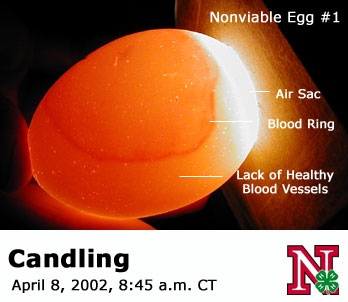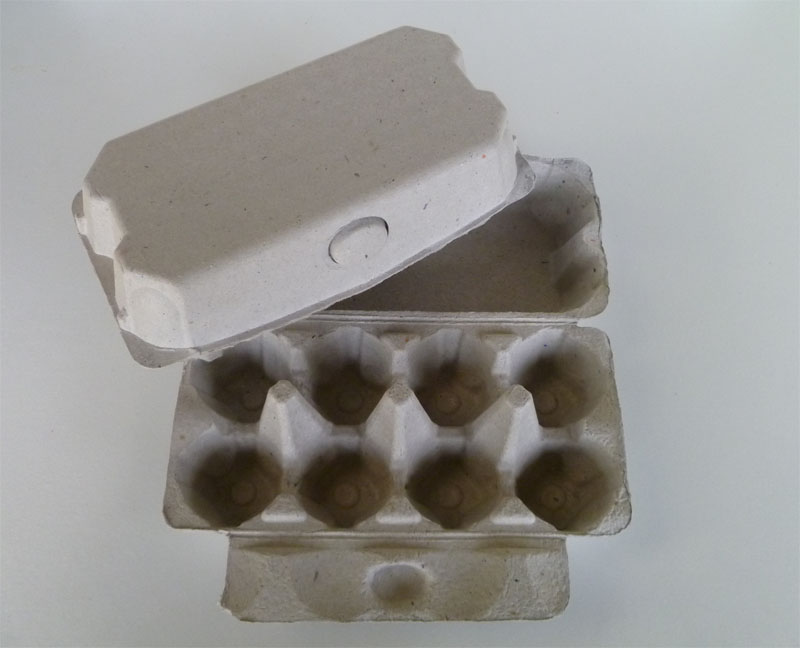 To start the day off, students met up at the chick lab but were immediately moved to the specialized research facility to look closer at eggs via candling. Students were set up around a large rectangular table and were given 6-8 eggs each all with different peculiarities and problems. The candling process then occurred and this is done by turning off all the lights in a room and holding each egg up to a light. The problems students noticed were commonly blood spots, blood rings, and thick, dark yolks, both of which indicate a poor quality egg. However, some problems with eggs were more different than normal such as a band around the shell of an egg as well as a non-moving yolk. The band around the shell indicates that when the egg was being coated, it was pushed forward a little bit too quickly resulting in a weak coating around this area. The immobilized yolk was a little more difficult to notice, but this is a very common issue with older, bad eggs.
To start the day off, students met up at the chick lab but were immediately moved to the specialized research facility to look closer at eggs via candling. Students were set up around a large rectangular table and were given 6-8 eggs each all with different peculiarities and problems. The candling process then occurred and this is done by turning off all the lights in a room and holding each egg up to a light. The problems students noticed were commonly blood spots, blood rings, and thick, dark yolks, both of which indicate a poor quality egg. However, some problems with eggs were more different than normal such as a band around the shell of an egg as well as a non-moving yolk. The band around the shell indicates that when the egg was being coated, it was pushed forward a little bit too quickly resulting in a weak coating around this area. The immobilized yolk was a little more difficult to notice, but this is a very common issue with older, bad eggs.After candling, students were brought to the main room in the specialized research facility and were split into two groups: 1 group for Haugh units and another for Specific gravity.
 Beginning with the test I did not fail when I took the class, specific gravity tests for the density and shell quality of an egg. Chelsie lead this demonstration and told the group that they were going to be using half of a flat from pullets (less than a year-old, female chickens) and half of a flat from old chickens so that comparisons and conclusions can be drawn from the difference in age and egg quality between the two. The specific gravity test occurs as such: Eggs in basket are placed into different salt-water density buckets and eggs that float are removed while eggs that sink stay in the basket. Here, students were divided into two groups again and were given either young or old eggs. Students then went from bucket removing the floating eggs and placing said eggs on the flats below the buckets. This continued until the last bucket (1.096 density) was reached and all the eggs were removed from the basket. Chelsie then charted out the egg densities and noted that the older eggs tended to be of poorer quality (less than 1.076) and thus had lower specific densities whereas the young eggs were of higher quality (around 1.080) and thus had higher specific densities.
Beginning with the test I did not fail when I took the class, specific gravity tests for the density and shell quality of an egg. Chelsie lead this demonstration and told the group that they were going to be using half of a flat from pullets (less than a year-old, female chickens) and half of a flat from old chickens so that comparisons and conclusions can be drawn from the difference in age and egg quality between the two. The specific gravity test occurs as such: Eggs in basket are placed into different salt-water density buckets and eggs that float are removed while eggs that sink stay in the basket. Here, students were divided into two groups again and were given either young or old eggs. Students then went from bucket removing the floating eggs and placing said eggs on the flats below the buckets. This continued until the last bucket (1.096 density) was reached and all the eggs were removed from the basket. Chelsie then charted out the egg densities and noted that the older eggs tended to be of poorer quality (less than 1.076) and thus had lower specific densities whereas the young eggs were of higher quality (around 1.080) and thus had higher specific densities. On the other side of the room, Dr. Parsons and I led the Haugh Unit testing which is a way to measure interior egg quality as well as shell quality. Students were lined up and handed one old egg, each. They then took the egg and broke it over a plate of glass. Next, they used the "Haugh Meter" which is used to asses the quality of the egg by testing the thickness of an eggs albumin, specifically the thick albumin. The thick albumin is the clear part of the egg surrounding the yolk that does not spread out (unlike the thin albumin that does spread out) after being cracked. Due to the fact that the students were dealing with old eggs, a majority of the eggs were of low quality and had thick albumin that spread out a lot and thus readings received were of very low-quality (less than 70 units). However, every now and then there was one durable egg that retained its thick albumin entirely and was of high quality (75-100 units).
On the other side of the room, Dr. Parsons and I led the Haugh Unit testing which is a way to measure interior egg quality as well as shell quality. Students were lined up and handed one old egg, each. They then took the egg and broke it over a plate of glass. Next, they used the "Haugh Meter" which is used to asses the quality of the egg by testing the thickness of an eggs albumin, specifically the thick albumin. The thick albumin is the clear part of the egg surrounding the yolk that does not spread out (unlike the thin albumin that does spread out) after being cracked. Due to the fact that the students were dealing with old eggs, a majority of the eggs were of low quality and had thick albumin that spread out a lot and thus readings received were of very low-quality (less than 70 units). However, every now and then there was one durable egg that retained its thick albumin entirely and was of high quality (75-100 units).Following this, the second part of the Haugh test is to check shell thickness. Students squeegeed their eggs off of the glass, and then came up to me where I held the egg-shell thickness measuring device. Students broke off small piece of the egg shell and set it between this device so that it pinched the shell between the scale and a small, metal pole. A good shell-quality would show units about 15, and a majority of these eggs did have good shell quality. This makes sense as an egg shell will not deteriorate over a month or two, however, the inside of an egg will deteriorate almost of it is perishable.
 The final part of this lesson was more of a fun-fact type thing and this was led by Dr. Parsons. He showed the class the many different egg containers, and label appeal that have been produced over the years. The funniest thing that he showed us was what also frustrated him most and that was the 8-egg egg-carton. Almost 100% of produced eggs in the world are put into either a multiple of a dozen or a half-dozen egg carton. Albeit, some mad-man in the world thought of this 'genius' idea to produce an 8-egg egg-carton. This frustrates Dr. Parson as well as most chicken farmers as this egg-carton does not fit into conventional egg pallets and boxes and thus creates extra difficulties with shipping and handling.
The final part of this lesson was more of a fun-fact type thing and this was led by Dr. Parsons. He showed the class the many different egg containers, and label appeal that have been produced over the years. The funniest thing that he showed us was what also frustrated him most and that was the 8-egg egg-carton. Almost 100% of produced eggs in the world are put into either a multiple of a dozen or a half-dozen egg carton. Albeit, some mad-man in the world thought of this 'genius' idea to produce an 8-egg egg-carton. This frustrates Dr. Parson as well as most chicken farmers as this egg-carton does not fit into conventional egg pallets and boxes and thus creates extra difficulties with shipping and handling.
The last thing Dr. Parsons showed us was the labels some companies made so that they could create appeal in a specific market. A lot of companies made labels that stated their eggs were 'organically' made, or that their chickens were grown 'cage-free' and allowed to roam outside. Chet could not handle this and came in on Dr. Parsons lesson and stated that 'cage-free' is defined as "A chicken having access to the outdoors" but that does not mean it has to be outside, it only has to have access. This is important, Chet explained as a majority of chickens do not like being outside where its windy, cold, and wet and, 'They would much rather be inside where its the temperature is controlled and food and water is always available.'
Overall, this class was very educational and experience that was so amazing that I now work at the poultry farms myself. I am learning so much about the poultry industry and am amazed at the work done by Dr. Parsons and Chet Utterback that I may change my plans for the future. Both the chicken and the egg are absolutely amazing creatures and food products, respectively, and honestly, to me, it does not matter which came first as they both are awesome.

Hello Alex,
ReplyDeletethank you for showing a part of our egg-quality measurment set.
If you are interested in more, you are welcomed to visit our webpage:
www.broering.de
www.futura-fuerste.de
best regards
Stefan Broering
stefan@broering.de